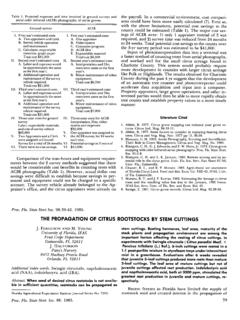Transcription of ORCHID PORTRAIT Lending Support - American Orchid Society
1 180 orchids MARCH PORTRAITL ending SupportBy Charles Marden FitchBranches, Logs, Plaques and Slabs Can Be Home to orchids Support ME, SHOUT THEorchids. I ll grow so well with theright Support . Sometimes our plants may soundlike demanding teenagers, yet pro-viding a lifetime Support is reasonablefor epiphytic orchids . In the wild,many of our most attractive orchidsthrive on tree branches, in clumps ofsturdy shrubs, on rocks covered withmoss or in a tree crotch filled with captivity, supports for orchidsresemble natural arrange-ments in supports includelogs of suitable wood, especiallyhardwoods, and lighter poles of sturdytree fern. Smaller orchids do well onchunks and slabs of tropical tree fern product, osmunda, madefrom the roots of a species of temperate-zone swamp plant, can also be used asa hanging Support . For years, chunksof osmunda were the preferred pottingmaterial for epiphytic orchids .
2 Densityof osmunda fern root varies from softto almost hard and dense. The hardersections are best for hanging of cork oak bark(Quercus suber), oak branches andgrape wood (Vitis vinifera) are goodas ORCHID supports. Driftwood fromfreshwater lakes and rivers is anattractive Support for epiphyticorchids, while that from the sea isbeautiful but usually saturated withsalts that harm ORCHID roots. Soakingin several changes of fresh water or afew months outdoors in the rain usuallywashes away enough of the sea salt tomake saltwater driftwood safe as anorchid pruned from living hardwoodtrees is suitable for orchids after beingdried for a few months. ORCHID growerand frequent winner of AOS awardsDennis Dayan of Deal, New Jersey,grows many of his small orchids onwood supports. Dayan told me thatseasoned (dried) fruitwood such asgrape and apple is good, but he avoidsusing wood from fruit trees with hard pits(stones) fruits such as cherry, peachand apricot.
3 According to Dayan, thestone-fruitwood bark has a chemical thatretards ORCHID root growth. ORCHID expertPhil Jesup of Bristol, Connecticut, hassuccess with orchids on sassafras(Sassafras albidum) using any type of wood thatABOVEM asdevallia infracta Devine ,CCM/AOS, still growing on the branch towhich is was originally attached. Forsuccess, mist on sunny mornings, providegood air circulation and night temperaturesof 55 to 60 F (13 to 16 C). This species isone of the successive-flowering membersof the genus; do not cut the inflorescencesoff until they are dry. Grower: Kristine RIGHTT hese cork tree branchesfor sale at a nursery are among the manychoices growers can use as mounts fororchids. Pieces of tree fern, osmunda anddriftwood (leached of all salts) are rhodosticta Fox Den ,JC/AOS, mounted on a log. This ORCHID ,native to Africa, thrives with diffuse light,intermediate to warm nights of 65 to 68 F(18 to 20 C) and regular waterings onsunny mornings.
4 It also grows well whenattached directly to the trunk of a pottedcoffee tree. Grower: Phil and Ann 2005 ORCHIDS181 PHOTOGRAPHS BY CHARLES MARDEN FITCH182 orchids MARCH PORTRAIT living inner bark. Older trees also offercork from thick branches. Cork slabssold for ORCHID growing are pricedaccording to weight or measured find that cork slabs last at least 10years. Usually the ORCHID outgrows theslab before cork bark deteriorates. (Incontrast, I find ground cork used aspotting mix needs replacement everytwo years.) Corks from wine bottles areuseful as slabs for tiny orchids and aspotting material, especially as wedgesto push rampant rhizomes back into acontainer. While most growers usepieces of cork as vertical slabs, a fewplace the piece of cork horizontally andattach the ORCHID to the raft. Equitantoncidiums and Psygmorchis pusilla arehas been pressure treated with woodpreservatives.
5 Generally, orchids dobest on totally natural unpainted wood,be it branches, slabs or ORCHID nurseries includevarious wood supports in the suppliessection of catalogs. Cork bark isuniversally available at orchidnurseries in many parts of the wood-type supports vary ac-cording to region. For example, inFlorida, cypress (Taxodium distichum)slabs and above-water wood knees are popular. In California, grapevinewood and cactus wood (skeletons) areoffered. Lowland tropical regions,often near the sea, are rich in coconuthusks and coconut shells (Cocosnucifera), both useful as orchidsupports). In temperate areas, hard-wood such as apple (Malus sp.)and oak (Quercus spp.) are bark of cork oaks(Quercus suber) comes mainly fromcommercial plantations in southernEurope, especially Spain and cork oaks also grow inCalifornia and a few Southwesternstates.
6 Cork is the outer bark, usually1/2 to 1 inch ( to cm) thick,removed from living trees. Sturdy corkoaks live well over 100 years, easilyproducing cork every eight or nineyears. Only the dead outer bark iscarefully removed without injury to theMaterials on Which to Mount Orchids71234561 Dense or hard osmunda fiber isrecommended for plants that requirea constant supply of moisture suchas miniature phalaenopsis oak bark slabs have a roughsurface that ORCHID roots grip tightlywhile still offering quick drainageand long life. Cork slabs can be usedvertically as seen here, or hung as ahorizontal Support similar to the logseen in photograph 5 on page log section cut from a 3-foot-(1-m-) long pole. Tree-fern poles aredense, hold moisture several days, andare suitable for many epiphytic chunks of tree fern are usefulfor equitant oncidiums. In the wild,these Caribbean species grow on twigsin bright osmunda is good to stuff a plasticmesh bag or other hanging Support forsmall orchids that do better when theroots can grow into a mount.
7 Smallerpseudobulbous epidendrums andbrassias thrive when attached to amesh bag filled with soft osmundahung in a bright bark chips are common asa potting material but may also bestuffed in mesh bags to createhanging supports or used around thebase of a mounted ORCHID set in aclay pot for tree fern is used mainly inpotting 2005 ORCHIDS183 PHOTOGRAPHS BY CHARLES MARDEN FITCH small enough to grow on a wine cork,as are companion tillandsias, some-times splitting the corks to grip theplant base. Tiny orchids do better ontraditional wine cork stoppers becausethe surface is more porous and naturalcork holds moisture, unlike the plasticcorks now on the market. However, thesynthetic stoppers can be used inorchid LIVING SUPPORTSI ndoors, potted tropical trees aresuitable living supports for species from the genera On-cidium, Epidendrum and Aerangis aregood choices to fasten directly on treebark or branches.
8 Of course, chunks oftree fern or cork holding orchids canalso be hung on the tree branches. Thismethod permits easy moving of indoor tropical trees forboth orchids and gardeners are: coffee(Coffea spp.), tea (Camellia sinensis)and citrus trees (Citrus spp.) includingfragrant flowered Meyer lemon (Citruslimon) and calamondin (Citrofortunellamitis). Citrus trees have sweetlyperfumed flowers. In my sunny photostudio in New York state, a singleflowering citrus shrub perfumes thewhole room. Grow these indoor treesin bright light with night temperaturesof 50 to 65 F (10 to 18 C), a goodtemperature range for many orchids . Asunroom, warmed bright porch,greenhouse or sunny southeast-facingwindow are all good locations for thesecharming indoor you grow trees in a lightweightpeat-based potting mix, the containersare easily moved outdoors in summermonths, where trees and orchids willthrive with rain, sun and increasedfresh air.
9 Large potted specimens canbe rolled outdoors on wooden dollybases, but take care when moving themover a door jam or up a foliage protects the orchids fromhot sun in a natural dappled light selections listed above can bepruned to mature in 12- to 20-inch (30- to50-cm) pots so, although technicallytrees, the plants are cultivated indoorsas well-pruned shrubs. Even my coffeetrees, grown from seed, get pruned fromtheir usual 10- to 15-foot (3- to 4-m) heightdown to a more comfortable 5 to 6 feet( to m) without EXOTIC SUPPORTSIn tropical regions, many orchids willthrive outdoors on living trees andshrubs. Favorite supports in gardenTOP LEFTThis miniature Brazilianspecies, Barbosella cogniauxiana MeredithMoore , CCM/AOS, is mounted on a slab ofcork. Grower: Dennis RIGHTA mesiella philippinensis, awarm-growing ORCHID , responds well to 60to 65 F (16 to 18 C) nights, diffuse light andmoist conditions.
10 Grower: J&L LEFTO ncidium longipes flowersfrom spring into early summer. Winternights of 60 to 65 F (16 to 18 C) with days10 to 15 F (5 to 8 C) warmer are the summer, place the plantoutdoors in a protected RIGHTB arkeria spectabilis GailSteiner , CCM/AOS, has slender growthsthat are well suited to growing on a tree-fern pole or log. It thrives in bright light and55 to 60 F nights (13 to 16 C). Mistingregularly with a fertilizer solutionencourages flowering. Grower: Dr. MARCH PORTRAIT stores. Grower Dayan likes to use blackbell wire for his mounted orchids . Smallorchids can also be attached with u-shaped staples, which are commonlyused to attach wire fencing. Thin clearmonofilament fishing line is almostinvisible and lasts for years, but it isnot easy to work orchids can be attached withthin strips of pantyhose (a choice ofcolors) or fine plastic mesh availablefrom recycled produce bags. Forexample, many fruits and vegetablescome in plastic mesh bags that can beeasily washed in the dishwasher orsink.






